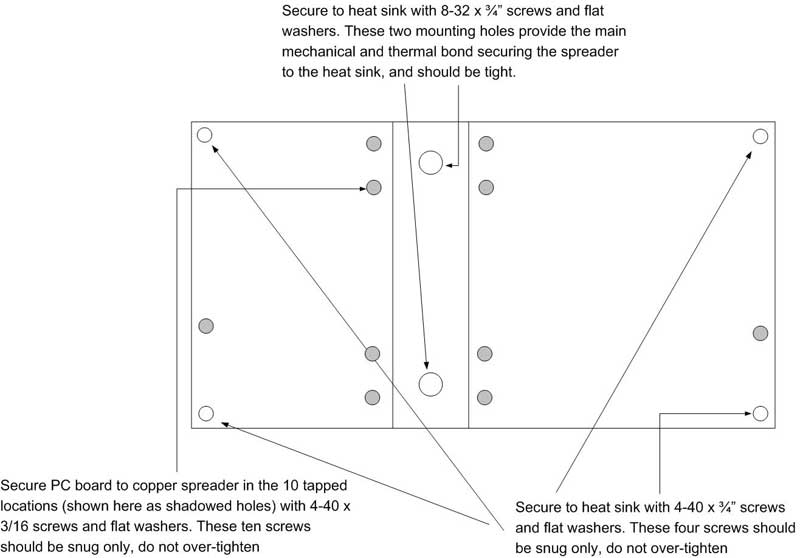
The amplifier produced from this kit is essentially the same as before; I made some small changes to the board layout when it was time to re-order circuit boards, and incorporated all the improvements added to the original kit as those became necessary. These are the changes made to the kit:
Several components were deleted that were previously used to provide platform stability. These were replaced with surface-mount parts R3, R7, C21, C22, C8 and C9, which control low frequency gain and provide the required stability; this change also makes the kit easier to assemble
The mounting holes were enlarged slightly for easier assembly
Additional ground foil was added to the board to make it easier to experiment with for possible future enhancements or other frequency ranges

Here's a link to a high resolution copy of the revised schematic diagram

Beginning with the output board, mount the surface mount capacitors as shown here. The smaller green mica is mounted so its forward edge is aligned with the trace transition (where it changes from wide to narrow).
Note the black mark near the end of
the lower drain trace near the center of the board...this was done with a narrow sharpie pen to mark the 30mm
distance from the beginning of the trace (more on this in a moment).

Add the drain chokes and the
electrolytic capacitors. The electrolytics are polarized parts, so be certain to
attach the negative leads to the ground foil, and positive leads to the VDD
traces.

Attach the coaxial matching capacitor
and the balun as shown here. The output board is finished.

Leaving the input coaxial balun for last, mount the input board parts. The small green trimmer must be mounted so it is not centered between the two gate traces, it must be offset so the round part in the center does not sit above the opposite trace. If centered, it will short the two traces together. Pre-align the adjustment slot on the trimmer to mid-range (it is set to mid-range in the photo).
To assist you with placement and
component identification, see the hi-res
photo here

In this last assembly step, slide the boards under the transistor tabs (transistor should have been previously flow-soldered to a copper spreader). The gate tabs were trimmed a bit before the transistor was mounted to provide clearance for C16 and C17.
Here is a video showing how to flow-solder your LDMOS to the spreader.
Here is the drilling template for the spreader.
Secure (but do not over-tighten) the boards to the spreader with 4-40 screws (2.5mm if you are using metric hardware with your own spreader).
Using a bit of liquid flux, solder the LDMOS tabs to the board.
 Fasten
the spreader to a suitable heat sink using the guide on the right. Use a
very thin coating of heat sink compound between spreader and heat sink (too
much, and it will actually impair heat transfer).
Fasten
the spreader to a suitable heat sink using the guide on the right. Use a
very thin coating of heat sink compound between spreader and heat sink (too
much, and it will actually impair heat transfer).
Turn on the 50v main supply voltage, but not the bias; there should be no current drawn
Turn on the bias and note the idling current drawn from the 50v supply. Adjust IDQ for 1 amp. Note: the current drawn by the bias supply (usually12v) is not what you are measuring here...you must measure the idling current (IDQ) the LDMOS draws from the 50v supply.
Shut off the power supply, and remove current limiting.